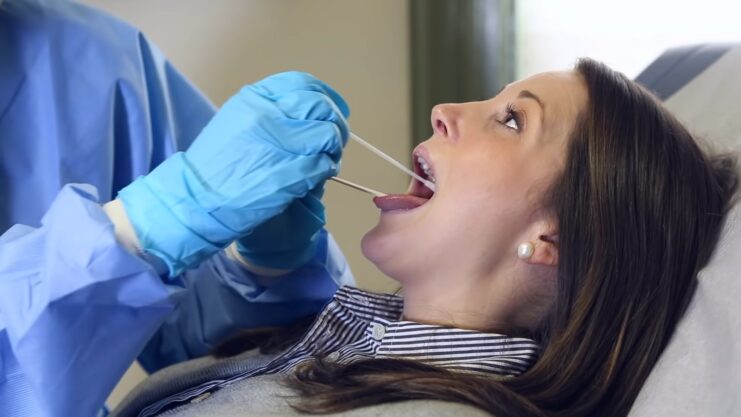There’s no denying that we are all familiar, to some extent, with Gonorrhoea. It’s an STD that affects both genders, manifesting as painful urination and a peculiar yellow discharge. It usually reveals itself between three to thirty days post-exposure, although a percentage of the infected population may not exhibit any symptoms.
Antibiotics can effectively treat it, but we are now facing a growing concern over antibiotic-resistant Gonorrhoea. However, there are lesser-known variations of this disease that tend to fly under the radar – Throat and Anal Gonorrhoea.

A common misconception is that Gonorrhoea is exclusive to the genital tract. The truth is, the Gonorrhoea bacterium seeks refuge in any part of the body that is soft, warm, and moist – an environment otherwise known as mucosa. The three main mucosal regions exposed to the external environment include the genital tract, anus, and throat. If the Gonorrhoea bacteria lands on these areas, it’s home sweet home.
In the throes of a sexual encounter, these three mucosal areas often come into contact. Consequently, it can potentially transfer from one area to another, irrespective of the nature of the sexual act involved. As long as one party carries the bacteria, the risk of transmission exists.
The Silent Culprit: The Unassuming Threat of Throat Gonorrhoea
The potential for often goes unnoticed. If you’ve engaged your mouth in a sexual act and your partner carries the Gonorrhoea bacterium, you could well be harboring throat Gonorrhoea, even without realizing it.
Strikingly, isn’t always accompanied by its urethral counterpart. It’s possible to contract throat Gonorrhoea, even with full penetrative sex, and remain symptom-free in the genital region. As doctors typically screen urine for Gonorrhoea, a throat infection can be easily overlooked.
Take this scenario, for instance. Mr. A was diagnosed with penile Gonorrhoea, treated, and sent on his way. Two weeks later, he returned with a fresh Gonorrhoea infection. His girlfriend, Ms. B, underwent a urine test that found no traces of it, leading her to believe Mr. A had been unfaithful. After a consultation and throat swab, it turned out Ms. B had been unknowingly transmitting Gonorrhoea back to Mr. A during their oral encounters. This situation illustrates how easily throat Gonorrhoea can fly under the radar.
The Stealthy Threat: Unmasking the Illusive Nature of Throat Gonorrhoea

Alarmingly, up to 95% of those infected with throat Gonorrhoea exhibit no symptoms at all. Only a minuscule percentage will suffer from a sore throat, fever, swollen lymph nodes, and pus on the tonsils. As such, the only reliable way to detect throat Gonorrhoea is through a throat swab.
Despite its elusiveness, throat Gonorrhoea is highly prevalent. Studies have found it in up to 6.8% of adolescent women and an astonishing 25% of Japanese men who also had urethral.
The bad news doesn’t stop there, though. This is notoriously more challenging to cure than its urethral counterpart. Even with a standard dose of antibiotics, the infection tends to persist in the throat. This not only proves problematic for the patient but also increases the risk of antibiotic resistance.

In summary, the danger posed by throat Gonorrhoea is multi-faceted. It’s often symptomless, difficult to cure, contributes to antibiotic resistance, can transfer to the genitals through oral sex, and frequently occurs independently of genital infections. Thus, if you suspect you might have contracted throat Gonorrhoea, don’t hesitate to see your doctor for a test. You’re not just safeguarding your health, but you’re also contributing to the fight against the silent spread of this overlooked infection.
FAQ
What causes Gonorrhoea?
Gonorrhoea is caused by the bacterium Neisseria gonorrhoeae. It spreads through sexual contact with an infected person. This includes vaginal, oral, and anal sex. It can also spread from mother to baby during childbirth.
Is it possible for throat Gonorrhoea to spread to other parts of the body?
Yes, it is possible for throat Gonorrhoea to spread to other parts of the body. The bacterium can transfer from the throat to the genitals during oral sex. Additionally, if the bacteria is on your hands or a sex toy, it can be transferred to other parts of the body that come into contact with the bacteria.
Is it dangerous if left untreated?
Throat Gonorrhoea, like any form, can cause complications if left untreated. Besides the discomfort of a possible sore throat, untreated can potentially facilitate the spread of the disease to other partners, even if you’re asymptomatic. Furthermore, untreated Gonorrhoea infections may increase your risk of getting or giving HIV.
How can I prevent getting Gonorrhoea, including throat Gonorrhoea?
The best method of prevention is through practicing safe sex. This includes using condoms or dental dams during any sexual activity. Getting regularly tested and knowing your partner’s sexual health status can also reduce your risk. If you test positive, it is crucial to inform all recent sexual partners, so they can get tested and treated as well.
How often should I get tested for Gonorrhoea?
If you’re sexually active, especially with multiple partners, you should be tested regularly for Gonorrhoea and other STIs. The frequency of testing will depend on your specific circumstances, but annual testing is a good starting point for most sexually active people. Remember, throat Gonorrhoea often presents no symptoms, so you may not know you’re infected without a test.
Can it be cured?
Yes, like other forms of Gonorrhoea, this can be cured with appropriate antibiotics. However, it’s important to take all of your prescribed medication, even if symptoms disappear before you’ve finished the course. Do note that while the disease can be cured, it does not provide immunity, meaning you can be re-infected.
What’s the relationship between antibiotic resistance and Gonorrhoea?
here’s a growing concern that is becoming more resistant to antibiotics, making it harder to treat. This is one reason why it’s so important to take the full course of your prescribed antibiotics. Incomplete treatment can contribute to the development of antibiotic-resistant strains of the bacteria. Moreover, the persistent nature of throat Gonorrhoea and frequent lack of symptoms can increase the likelihood of such resistance developing.
Bottom Line
The silent threat of Throat Gonorrhoea should not be overlooked. Its asymptomatic nature, resistance to treatment, risk of antibiotic resistance, and potential for transmission to other parts of the body make it a crucial concern for sexually active individuals. Despite being less known than its genital counterpart, it’s equally dangerous and can have serious health consequences if not detected and treated early.
As such, it is essential to adopt safer sexual practices, get regularly tested if sexually active, and spread awareness about this under-discussed issue. The fight against Gonorrhoea, in all its forms, starts with understanding and communication.
Related Posts:
- Throat Gonorrhea: The Silent STD You Need to Know About
- Cough, Sore Throat and Rash – Are These Signs of HIV or ARS?
- The Meaning Behind the Upside-Down Pineapple: More…
- More On HIV Symptoms - Unmasking the Signs
- Boosting Your Etsy Shop: Tips and Tricks to Get More Sales
- STD Symptoms in Receptive Oral Sex: The Hidden Threat












